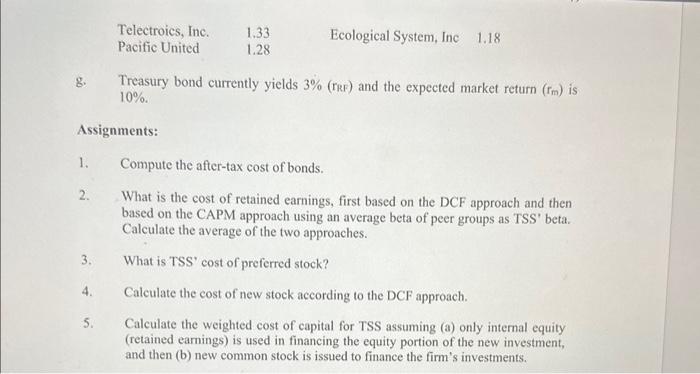The Triple Seven Systems, Inc. (TSS), is starting its planning process for next year. Jack Tripper, the firm's CFO, calculates the weighted cost of capital each year to be used as a discount rate in the NPV analysis. You have been asked to help Mr. Tipper to compute the firm's cost of capital. You have collected the following data to do the job: a. TSS bonds carry a coupon rate of 6% with semi-annual payments, a $1,000 par, a AAA rating, and a maturity of 10 years. The current price of the TSS bonds is $950. b. TSS preferred stock currently pays a 10% dividend rate on a $100 par value and has a market value of $95 per share. c. TSS common shares paid a dividend of $5 last year. Dividends have grown at a rate of 6% per year and are expected to continue for a foreseeable future. The market price of the stock is $55 and there would be a flotation cost of 5% on a new issue. d. TSS' capital structure is as follows: e. The firm's average tax rate is 35% and its marginal tax rate is 40%. f. TSS uses five companies for peer-group comparisons. These five firms along with their betas after being adjusted for financial leverage effects are as follows: g. Treasury bond currently yields 3%(rRF) and the expected market return (rm) is 10% Assignments: 1. Compute the after-tax cost of bonds. 2. What is the cost of retained earnings, first based on the DCF approach and then based on the CAPM approach using an average beta of peer groups as TSS' beta. Calculate the average of the two approaches. 3. What is TSS' cost of preferred stock? 4. Calculate the cost of new stock according to the DCF approach. 5. Calculate the weighted cost of capital for TSS assuming (a) only internal equity (retained earnings) is used in financing the equity portion of the new investment, and then (b) new common stock is issued to finance the firm's investments. The Triple Seven Systems, Inc. (TSS), is starting its planning process for next year. Jack Tripper, the firm's CFO, calculates the weighted cost of capital each year to be used as a discount rate in the NPV analysis. You have been asked to help Mr. Tipper to compute the firm's cost of capital. You have collected the following data to do the job: a. TSS bonds carry a coupon rate of 6% with semi-annual payments, a $1,000 par, a AAA rating, and a maturity of 10 years. The current price of the TSS bonds is $950. b. TSS preferred stock currently pays a 10% dividend rate on a $100 par value and has a market value of $95 per share. c. TSS common shares paid a dividend of $5 last year. Dividends have grown at a rate of 6% per year and are expected to continue for a foreseeable future. The market price of the stock is $55 and there would be a flotation cost of 5% on a new issue. d. TSS' capital structure is as follows: e. The firm's average tax rate is 35% and its marginal tax rate is 40%. f. TSS uses five companies for peer-group comparisons. These five firms along with their betas after being adjusted for financial leverage effects are as follows: g. Treasury bond currently yields 3%(rRF) and the expected market return (rm) is 10% Assignments: 1. Compute the after-tax cost of bonds. 2. What is the cost of retained earnings, first based on the DCF approach and then based on the CAPM approach using an average beta of peer groups as TSS' beta. Calculate the average of the two approaches. 3. What is TSS' cost of preferred stock? 4. Calculate the cost of new stock according to the DCF approach. 5. Calculate the weighted cost of capital for TSS assuming (a) only internal equity (retained earnings) is used in financing the equity portion of the new investment, and then (b) new common stock is issued to finance the firm's investments









